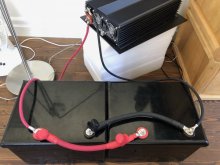While you have the system under load, and you have the current difference, measure all of the cell voltages with the same meter. Try to measure on the actual cell terminal, not the buss bar. If the 4 cells add up to more than the total reading, then you know you have a bad connection. Also measure from cell terminal to cell terminal across a buss bar to check for voltage drop. At 100 amps, you will see a few millivolts on a good connection, but what you are really looking for is one that is different than the rest. If one buss bar is dropping twice the voltage of the others, the you know that is likely a bad connection. At full charge, above the knee, it is not that bad to see a few amps difference. If you increase the load to 100 amps, and the difference is still less than 10 amps, it is not that bad. As the cells come down below the knee, they should balance out. With the very flat discharge curve and low internal resistance on LFP cells, it only takes a tiny state of charge difference to cause a current balance error. After just a few minutes though, the string that is pulling more current will drop it's state of charge a little faster and therefore the internal voltage will slowly balance out and the current difference will fade down. This is a self balancing effect. Both during charge and discharge, the cell pulling more current will catch the ones at less current until they reach a balance point. If one pack has more actual capacity, it may just run the whole time at a little more current to reach full and empty at the same time as the weaker cell. If it is less than 10% different, don't stress over it. Just know you can't pull 2x the current of one pack, maybe just 80% more with a second pack, to allow for the imbalance. If you have 2 batteries rated at supplying 100 amps, you may only be able to pull 180 amps before the stronger battery is at it's 100 amp limit, while the weaker one is at 80 amps.




